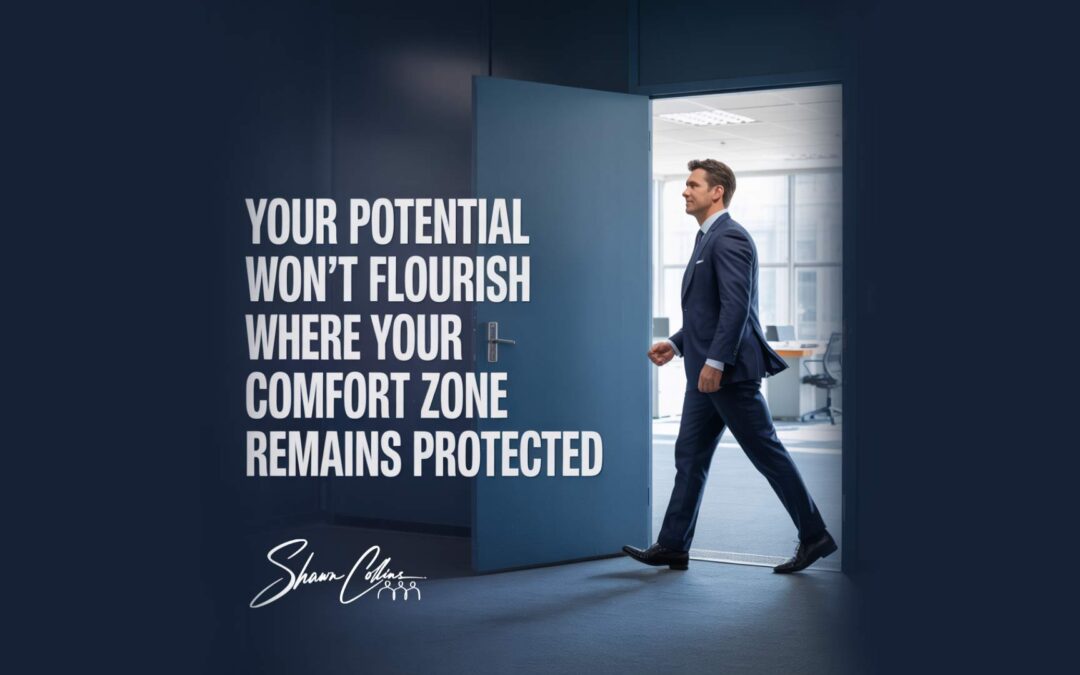“Your potential won’t flourish where your comfort zone remains protected.”
Every leader understands that success often comes with challenges. However, many cling to their comfort zones, believing that safety equates to stability. The reality is, your potential won’t flourish where your comfort zone remains protected. This statement embodies a crucial mindset shift, one that can ignite growth and innovation in both personal and organizational landscapes.
The comfort zone is that mental space where you feel safe and secure. It’s where things are predictable and routine, but this predictability can dull your edge. It’s tempting to stay there, especially when leadership comes with immense pressure and responsibility. Yet, by remaining in this zone, you risk stagnation. You become blind to opportunities for improvement, innovation, and engagement.
Embracing discomfort isn’t just a personal growth strategy. It’s a catalyst for organizational transformation. Leaders who step beyond their familiar boundaries foster environments where creativity flourishes and risks are analyzed rather than avoided. Organizations thrive on this mindset shift; they become agile, ready to pivot in the face of new challenges, and reoriented towards growth.
This blog will explore how breaking down your comfort zones not only enhances your effectiveness as a leader but also propels your organization forward. Welcome to the journey of redefining what’s possible.
Understanding the Comfort Zone
The comfort zone is more than just a cozy nook—it’s a mental barrier with deep psychological roots. From a behavioral perspective, your comfort zone comprises familiar routines, environments, and interactions that make you feel secure. It’s predictable, and predictability can breed complacency.
Why Do Leaders Cling to Their Comfort Zones?
Understanding why leaders and organizations stay within their comfort zones is crucial to addressing the issue. Here are some common reasons:
- Fear of Failure: Many leaders dread the prospect of failure. This fear can paralyze decision-making and discourage risk-taking.
- Perceived Stability: With the weight of responsibility, it’s easy to equate comfort with stability. Making bold moves can feel like stepping into chaos.
- Prior Successes: Past achievements can create a false sense of security. It’s tempting to stick with what worked before instead of exploring new avenues.
- Lack of Vision: Without a clear vision for the future, it’s simpler to remain in familiar territory rather than chart new paths.
The Risks of Staying Protected
While leaning on your comfort zone feels safe, the risks are significant. Consider these potential pitfalls:
- Stagnation: When you’re not challenged, both you and your organization risk stagnation. This leads to outdated practices and missed opportunities.
- Reduced Engagement: Employees often mirror leadership attitudes. If leaders avoid discomfort, employees may feel the same, reducing overall engagement and innovation.
- Inability to Adapt: The business world is in constant flux. Clinging to comfort zones makes it harder to pivot and respond effectively to new challenges.
- Decreased Competitive Edge: Innovation stagnates within the comfort zone, resulting in a decline in competitive advantage.
Staying stuck can mean falling behind.
In essence, protecting your comfort zone limits both personal and organizational growth. Recognizing these patterns is the first step toward breaking free and embracing the discomfort necessary for personal growth and advancement.
The Cost of Staying Comfortable
Staying in your comfort zone might feel safe, but the truth is, it’s a false sense of security that comes at a steep price. When leaders and organizations resist stepping out of their familiar confines, they face a range of detrimental consequences that impede growth and innovation.
Stagnation: The Silent Progress Killer
When comfort prevails, progress stalls. You might notice some symptoms of this stagnation:
Missed Opportunities: When you’re not open to trying new approaches, you may overlook valuable opportunities for innovation. For instance, a market shift may favor businesses that adapt quickly, leaving others behind.
Outdated Practices: Reliance on familiar strategies breeds mediocrity. Remember Kodak? By sticking to its film-based business model, it failed to embrace the digital camera revolution and ultimately faltered.
Employee Engagement Takes a Hit
You’ve likely heard that employee engagement is vital for overall success. Yet, when leaders shy away from discomfort, it sends a clear message to the team: staying comfortable is the status quo. This can manifest in various ways:
- Lack of Initiative: Employees are less likely to propose new ideas when leadership demonstrates a fear of stepping outside their comfort zones.
- Increased Turnover: Highly engaged employees often seek opportunities for growth. If they sense their leaders are stagnant, they may look for greener pastures elsewhere.
Slowed Business Growth
Business growth relies on agility and the willingness to take calculated risks. Sticking to comfort zones can significantly hinder expansion efforts:
- Reduced Innovation: Without a culture that promotes risk-taking, innovation stalls. Companies like Blockbuster illustrate this well; their reluctance to adapt to online streaming left them behind.
- Decreased Market Relevance: Clinging to outdated practices can lead to a company’s decline. If you’re not evolving, your market relevance diminishes over time.
The longer you and your organization protect the comfort zone, the deeper the roots of stagnation grow. Research supports this notion: a study from Gallup found companies with highly engaged employees outperform their rivals by 147% in earnings per share. Clearly, investment in discomfort pays off.
In summary, though it may feel easier to stay rooted in what you know, you’re paying a hefty price. By recognizing how comfort zones impede progress, you can begin taking the necessary steps toward a more dynamic and fulfilling path for both you and your organization.
Why Discomfort is Essential for Growth
Embracing discomfort is not merely an option; it’s a necessity for cultivating growth in any organization. Research shows that stepping outside your comfort zone fosters not just individual resilience but also collective organizational capabilities. Here’s why discomfort is a vital ingredient for success.
Fostering Creativity
Creativity often thrives in environments rich with challenges. When you expose yourself and your team to situations that feel uncomfortable, you stimulate innovative thinking and problem-solving. This can result in:
- Diverse Perspectives: Engaging with new ideas and viewpoints encourages collaboration and can lead to breakthroughs that wouldn’t happen in a risk-averse setting.
- Adaptability: Unfamiliar situations enhance your ability to think on your feet and adjust your strategies spontaneously. This flexibility can be a significant advantage in a rapidly changing marketplace.
Building Resilience
The ability to bounce back from setbacks is crucial for leadership and organizational success. When discomfort becomes a regular part of your routine, you and your team will learn to:
- Navigate Uncertainty: Facing challenges head-on builds confidence. Instead of fearing failure, your team will view obstacles as opportunities for learning and growth.
- Strengthen Problem-Solving Skills: Overcoming difficulties enhances critical thinking and equips your team with the skills needed to tackle future challenges effectively.
Enhancing Leadership Development
Authentic leadership emerges when individuals choose to overcome fear and uncertainty. Leaders who consistently challenge their comfort zones demonstrate:
- Authentic Leadership: A willingness to take risks and show vulnerability inspires trust and respect among team members.
- Mentorship Opportunities: By modeling discomfort, you set a precedent for others. This encourages upcoming leaders within your organization to embrace challenges rather than shy away from them.
Cultivating Organizational Agility
In today’s fast-paced business world, agility is king. Organizations that thrive are those that can pivot quickly in response to shifts in the industry or changing consumer demands. Discomfort plays a key role in enhancing this agility:
- Dynamic Decision-Making: Teams accustomed to operating outside their comfort zones are more likely to make swift, info
- Innovation Culture: Creating a culture that rewards experimentation helps in keeping the organization relevant. When employees know that taking risks is welcomed, they’re more likely to propose new ideas that can propel the business forward.
To truly thrive, leaders must be willing to embrace the uncomfortable. By doing so, you cultivate creativity, build resilience, develop leadership potential, and create an agile organization prepared for whatever comes next. Remember, growth is often just outside your comfort zone—don’t be afraid to step into it.
Case Studies of Leaders and Organizations That Embraced Discomfort
When it comes to breaking the mold, sometimes you need real-world examples to inspire you. Here are several notable leaders and organizations that stepped out of their comfort zones, took strategic risks, and achieved remarkable results.
- Howard Schultz and Starbucks: Under Howard Schultz’s leadership, Starbucks didn’t just grow; it reinvented the coffee experience. Schultz faced significant criticism when he decided to close all U.S. stores for a few hours to retrain baristas on crafting the perfect espresso. This bold move recognized the need for quality over mere profitability. The result? Starbucks strengthened its brand and customer loyalty, showcasing how taking calculated risks can lead to substantial growth.
- Satya Nadella and Microsoft: When Satya Nadella took over as CEO of Microsoft, he made a push towards a culture of collaboration and learning. He dismantled rigid structures and encouraged employees to embrace a “growth mindset.” Nadella initially faced significant pushback, but this discomfort led to a revitalization of Microsoft’s products and a dramatic increase in market value. By fostering an innovative atmosphere, Microsoft saw a resurgence in relevance within the tech landscape.
- Airbnb’s Adaptation during Crises: Airbnb has faced challenges, especially during the pandemic. Instead of hunkering down, CEO Brian Chesky encouraged the team to explore new avenues. They quickly pivoted to offer online experiences, allowing hosts to showcase their skills from home. Not only did this move help sustain the business during trying times, but it also opened up new revenue streams, showing how embracing discomfort can lead to creativity and resilience.
- Daring Initiatives in Human Resources: Consider a mid-sized tech company that tackled its stagnating employee engagement. The HR leader conducted open feedback sessions where team members were encouraged to express their frustrations. This decision felt uncomfortable for many leaders who feared negative pushback. However, the initiative led to actionable insights and ultimately spurred changes such as flexible work arrangements and professional development programs. By promoting a culture of openness, the company experienced a substantial boost in morale and engagement.
- The Risk Paid Off for a Startup: A small startup in the health tech space decided to challenge the status quo by introducing a unique customer feedback loop that went beyond conventional surveys. They held focus groups that directly involved users in the development process. This step was uncomfortable, but it led to a product that resonated deeply with their target audience. The startup not only captured significant market interest but also established a loyal customer base that felt heard and valued.
These examples illustrate that when leaders and organizations dare to step beyond their comfort zones, they can not only survive but thrive. Each of these cases underscores how embracing discomfort has enabled meaningful change, driving innovation and growth in ways that would have been impossible within the confines of familiarity.
Practical Strategies to Move Beyond Your Comfort Zone
It’s one thing to talk about stepping outside your comfort zone and quite another, actually, to do it. Implementing strategies that encourage this shift requires deliberate effort and planning. Here are several practical steps tailored for executives, HR professionals, and entrepreneurs designed to break through the barriers of comfort and foster growth.
Mindset Shifts
Changing your mindset is fundamental to moving beyond comfort. Begin by:
- Embracing a Growth Mindset: Cultivate a belief that abilities can develop through dedication and hard work. Encourage your team to view challenges as opportunities for learning rather than threats.
- Reframing Failure: Shift the narrative around failure. Instead of seeing it as a negative outcome, frame it as a stepping stone to success. Discuss failures openly to normalize risk-taking.
- Encouraging Curiosity: Foster an environment where asking questions and exploring new ideas is valued. Encourage team members to seek out unfamiliar territories and perspectives.
Fostering Psychological Safety
A safe environment is essential for fostering risk-taking and innovation. To create psychological safety:
- Lead by Example: Show vulnerability by sharing your own challenges and uncertainties. When team members see leaders confronting discomfort, it creates a trickle-down effect.
- Encourage Open Communication: Establish channels where employees can voice their concerns or ideas without fear of judgment. Regularly gather feedback and act on it to show that all voices matter.
- Celebrate Efforts, Not Just Outcomes: Acknowledge and reward experimentation and calculated risks, even if they don’t lead to immediate success. This reinforces that the process is just as important as the results.
Encouraging Calculated Risks
Taking risks doesn’t mean being reckless. To encourage calculated risks:
- Set Clear Parameters: Define what constitutes a ‘calculated risk’ for your team. Provide guidelines to support informed decision-making while allowing room for discretion.
- Run Small Experiments: Test ideas on a small scale before committing to larger initiatives. This might include pilot projects or short-term trials that allow for learning without significant fallout.
- Review and Reflect: After taking a risk, facilitate discussions about what was learned, regardless of the outcome. This reflection helps reinforce a cycle of continuous improvement and adaptation.
Continuous Learning Frameworks
To maintain momentum in moving beyond comfort, establish frameworks that emphasize continuous learning:
- Invest in Training: Provide access to learning resources, workshops, or mentorship programs that focus on developing new skills and competencies, particularly in unfamiliar areas.
- Encourage Cross-Functional Collaboration: Create opportunities for team members to collaborate across departments, ensuring diverse perspectives and skills are brought together to tackle challenges.
- Organize Regular Workshops: Host workshops and brainstorming sessions focused on pushing boundaries and exploring innovative solutions. Encourage teams to tackle real issues they face in the organization.
Stepping outside your comfort zone is a journey, not a single leap. By implementing these strategies, you will not only enhance your personal growth but also cultivate a culture of innovation and resilience within your organization. Remember that the discomfort you encounter along the way is a sign that you’re on the right path toward meaningful progress.
Building a Culture That Rewards Growth Over Comfort
Creating an environment where employees are motivated to push beyond their comfort zones is vital for any leader looking to drive growth and innovation. As HR leaders and executives, your role is pivotal in establishing a culture that not only allows but encourages discomfort for the sake of development. Here’s how you can achieve this transformation.
Leadership Modeling
Leadership sets the tone. When leaders actively step outside their own comfort zones, they inherently inspire their teams to do the same. This can take many forms:
- Share Your Journey: Be open about your own challenges and the discomfort you’ve faced. Sharing personal stories of risk-taking can resonate deeply and encourage others to take similar risks.
- Take Bold Actions: Whether it’s making a tough decision or trying out a different strategy, showcasing decisive actions in uncertain situations demonstrates to your team that risk-taking is worthwhile.
- Encourage Transparency: Foster a culture of openness where vulnerability is accepted. When leaders demonstrate authenticity, it cultivates an environment where team members feel safe to explore their discomfort.
Incentives That Encourage Growth
Reevaluating your incentive structures can significantly impact how comfortable your employees feel with discomfort. Consider the following:
- Recognize Risk-Takers: Create awards or recognitions for team members who step outside their comfort zones, even if the outcomes aren’t always successful. This sends a message that effort and initiative are valued.
- Innovative Project Funding: Allocate resources to support new ideas or projects proposed by employees. Providing funding for calculated risks demonstrates that the organization is committed to innovation.
- Include Growth Metrics in Performance Reviews: Shift performance metrics to include how well employees embrace challenges and contribute to a culture of growth. This encourages everyone to pursue opportunities that stretch them beyond their comfort zones actively.
Training and Development Opportunities
Investing in your employees’ growth through training can spark their willingness to step beyond their comfort zone. Implement these strategies:
- Offer Workshops on Risk Management: Educate employees on how to assess and mitigate risks effectively. This empowers them to make informed decisions that stretch their capabilities.
- Provide Access to Mentorship Programs: Pair less experienced employees with mentors who challenge them to explore new ideas and approaches. This guidance can foster confidence and the willingness to embrace discomfort.
- Host Cross-Functional Training Sessions: Encourage employees to learn from other departments, broadening their perspectives and fostering an environment that welcomes diverse experiences and ideas.
Feedback Loops to Foster Engagement
Creating robust feedback mechanisms is essential in promoting a growth mindset. Implement these steps:
- Regular Check-Ins: Conduct frequent one-on-one meetings to discuss challenges and areas of comfort. This provides employees with an opportunity to express their concerns and receive guidance on how to navigate discomfort.
- Anonymous Surveys: Create confidential platforms for employees to provide input about the organizational culture and suggest areas where they feel they could be challenged more effectively.
- Celebrate Failures as Learning Opportunities: When a project doesn’t go as planned, analyze what went wrong without placing blame. Use failures as learning case studies to reinforce that taking risks is a part of growth.
By implementing these strategies, you foster a culture that prioritizes growth over comfort. When employees see that stepping outside their comfort zones is rewarded, valued, and supported, they are more likely to engage in the discomfort necessary for personal and organizational growth.
Measuring Progress and Sustaining Momentum
Tracking growth beyond comfort zones is more than just a numbers game. It’s about understanding how well you’re pushing boundaries and exploring new capabilities. To maintain forward momentum, leaders must implement relevant metrics and tools that ensure accountability and foster ongoing improvement. Here’s how you can effectively measure progress and sustain growth.
Key Metrics for Measurement
The first step is to identify metrics that can capture the nuances of growth outside of comfort zones. Consider the following:
- Innovation Metrics: Measure the number of new ideas generated by your team, and track how many make it into implementation. Growth in these areas indicates a more dynamic, risk-taking culture.
- Employee Engagement Scores: Utilize surveys to gauge employees’ feelings about taking risks. Improved engagement scores often correlate with healthier organizational cultures.
- Project Success Rates: Monitor the outcomes of initiatives aimed at risk-taking. Higher success rates in these projects indicate effective navigation of discomfort and a willingness to innovate.
- Feedback Frequency: Track the number of constructive feedback sessions held to discuss discomfort and innovation. Regular conversations serve as indicators of a culture in evolution.
Tools to Foster Accountability
Utilize various tools and frameworks to support measurement and accountability:
- Performance Dashboards: Set up dashboards that visualize key metrics in real-time. These dashboards provide insights at a glance, making it easier to identify trends and areas that require attention.
- Annual Development Plans: Implement individual development plans that set specific goals related to stepping outside comfort zones. Reviewing progress towards these goals during performance reviews can ensure accountability.
- Regular Reflective Sessions: Schedule time for teams to reflect on their discomfort experiences. Use these sessions to analyze what worked, what didn’t, and how to approach future challenges.
- Mentorship Pairing: Match employees with mentors who can help guide them through their personal growth and development journeys. Documenting these interactions can offer a valuable perspective on personal growth.
Long-Term Evolution Strategies
Sustaining momentum requires a consistent commitment and strategic approach. Here are the steps to ensure continued evolution:
- Celebrate Milestones: Acknowledge significant achievements related to risk-taking. Recognition reinforces positive reinforcement and encourages future attempts to step outside of comfort zones.
- Adjust Goals Continuously: As your organization evolves, so should your goals. Regularly reassess metrics and adjust them to ensure they accurately capture your journey beyond comfort.
- Maintain Open Lines of Communication: Keep discussions about discomfort open. Encourage employees to share their experiences, challenges faced, and any support they may need from leadership.
- Incorporate Lessons Learned: Develop a repository of lessons learned from discomfort experiences. This serves as a valuable resource for future initiatives and helps normalize the discomfort journey.
Measuring progress isn’t just an evaluation; it’s a vital part of fostering a culture where discomfort is embraced. By utilizing the right metrics and tools, you can ensure accountability and sustain long-term growth, paving the way for a resilient and innovative organization. Your willingness to engage with discomfort will set the tone for a thriving environment that pushes boundaries and promotes continuous evolution.
Embracing discomfort is not just a necessity; it’s a vital investment in your personal and professional growth. As we’ve explored throughout this blog, remaining in your comfort zone significantly hinders your potential. It stifles creativity, limits innovation, and can lead to stagnation within your organization.
Here are some key takeaways:
- Recognize and confront your comfort zones: Understand that they exist and take proactive steps to challenge them.
- Encourage a culture of risk-taking: Foster an environment where discomfort is seen as a pathway to growth rather than a threat.
- Invest in your team: Provide training and support that empower your employees to step outside their familiar boundaries.
- Measure progress: Use metrics to track how effectively you are pushing past comfort zones and fostering innovation.
The path of growth is rife with challenges, but each step outside of your comfort zone is a step toward a more dynamic and prosperous future. As leaders and change-makers, it’s essential to initiate this journey not just for yourself but to inspire those within your organization. Challenge your comfort zones today. Start small if you must, but act decisively. The dividends of discomfort will yield personal and organizational rewards that far surpass the illusion of convenience.




